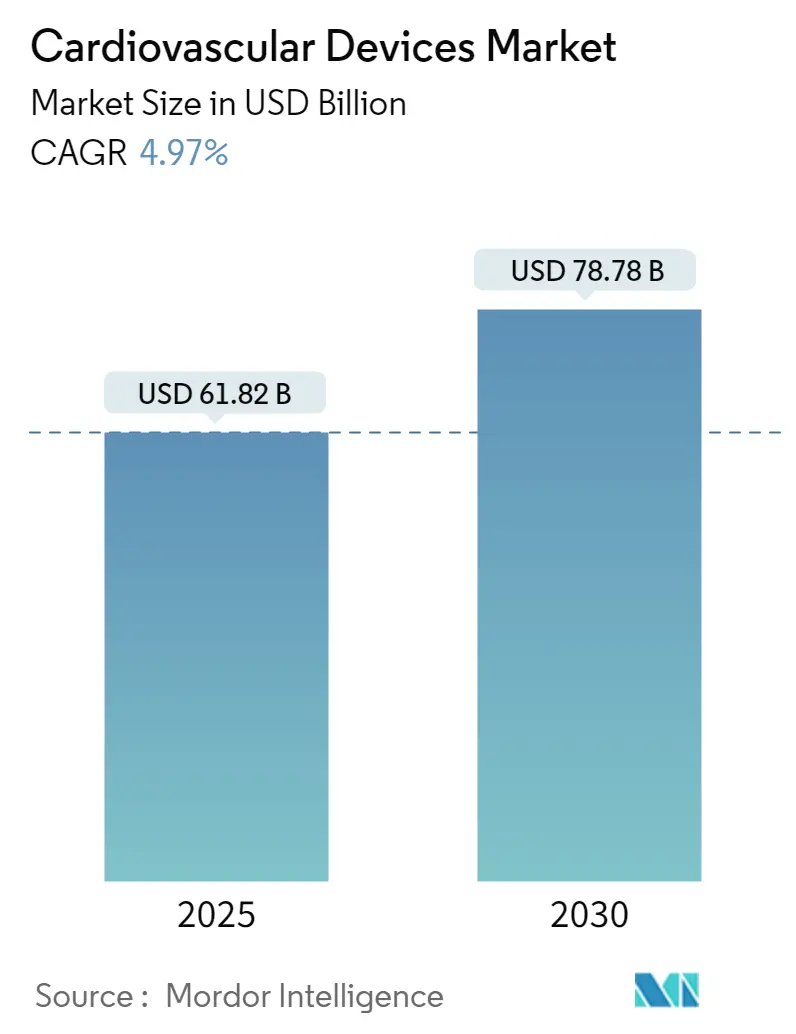
| Study Period | 2021 - 2030 |
| Market Size (2025) | USD 61.82 Billion |
| Market Size (2030) | USD 78.78 Billion |
| CAGR (2025 - 2030) | 4.97 % |
| Fastest Growing Market | Asia Pacific |
| Largest Market | North America |
| Market Concentration | Medium |
Major Players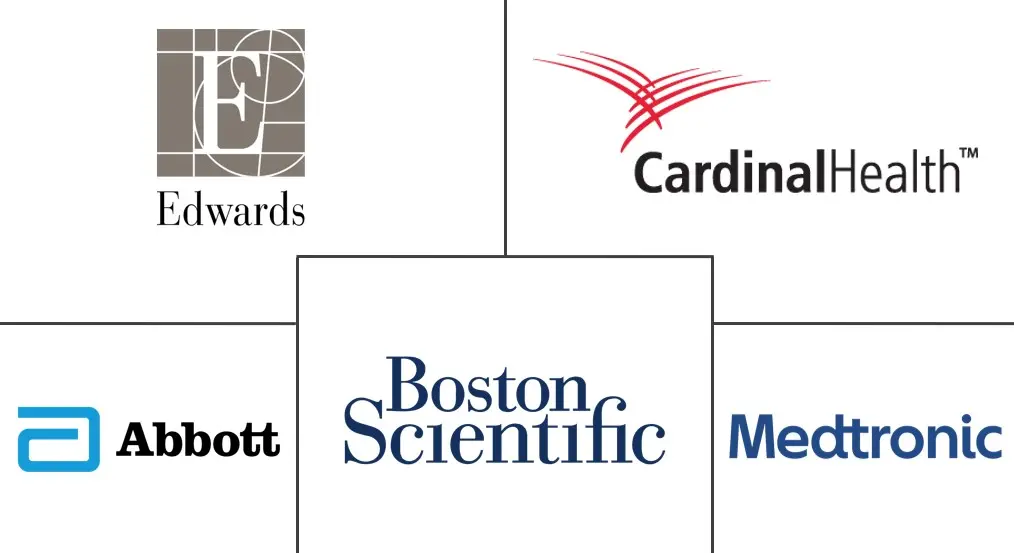
*Disclaimer: Major Players sorted in no particular order |
Cardiovascular Devices Market Analysis
The Cardiovascular Devices Market size is estimated at USD 61.82 billion in 2025, and is expected to reach USD 78.78 billion by 2030, at a CAGR of 4.97% during the forecast period (2025-2030).
Precision Medicine Reshapes Cardiovascular Care Pathways
The cardiovascular devices landscape in 2025 reflects a fundamental shift toward precise, patient-tailored interventions. Clinical research is increasingly focusing on targeted therapies that address specific cardiovascular pathways, exemplified by Novartis' completion of patient enrollment in the pivotal Phase 3 Lp(a) HORIZON cardiovascular outcomes study, which included 8,325 participants to evaluate cardiovascular event reduction in patients with established cardiovascular disease and elevated lipoprotein(a). This represents a broader industry pivot toward precision medicine, where cardiovascular devices are increasingly designed to address specific patient subpopulations rather than one-size-fits-all approaches. Device manufacturers are responding by developing more specialized tools that integrate with diagnostic biomarkers and genetic profiles. For healthcare providers, this evolution demands more sophisticated patient stratification protocols and specialized training for clinicians who must navigate an increasingly complex treatment landscape. The implications are far-reaching: healthcare systems that fail to adapt their cardiovascular service lines to accommodate these precision-driven approaches risk falling behind in their ability to deliver optimal patient outcomes and maintain market share in competitive healthcare environments. Forward-thinking healthcare administrators should be planning now for the infrastructure investments needed to support the next generation of targeted cardiovascular therapies and the devices that enable them.
Surgical Innovations Drive Procedural Excellence in Cardiac Care
The integration of advanced imaging and monitoring technologies has transformed cardiac surgery procedures, creating a new standard for intraoperative decision-making and quality control. A compelling example comes from the REQUEST Study, where 25% of patients experienced one or more surgical procedure changes when integrating Transit Time Flow Measurement (TTFM) with High Frequency Ultrasound Imaging (HFUS) during CABG surgery. This significant procedural modification rate demonstrates how real-time feedback technologies are fundamentally changing surgical approaches and improving outcomes. Cardiac care centers are increasingly adopting these technologies not merely as optional enhancements but as essential quality control mechanisms that reduce complications and revision surgeries. For cardiac device manufacturers, this represents an opportunity to develop integrated systems that provide surgeons with comprehensive intraoperative intelligence rather than isolated data points. Hospital administrators facing capital equipment decisions should recognize that investments in these advanced surgical technologies directly impact clinical outcomes and ultimately influence referral patterns and institutional reputation. The competitive landscape in cardiac care now demands that hospitals maintain technological parity or risk losing complex cardiac cases to better-equipped competitors. The integration of these technologies also creates new training requirements for surgical teams, necessitating comprehensive educational programs and simulation-based learning opportunities.
Cardiovascular Disease Burden Ensures Market Resilience
Despite economic fluctuations and changing healthcare priorities, cardiovascular disease remains a persistent and dominant force in global healthcare, creating a resilient foundation for the cardiovascular devices market. According to the 2024 global medical trend report, cardiovascular diseases rank as the second major condition globally, following only cancer/tumor growth. This enduring disease burden translates to sustained demand for cardiovascular devices across diagnostic, monitoring, and therapeutic categories. Unlike more volatile segments of healthcare that may be subject to fashion, policy shifts, or economic cycles, cardiovascular disease management represents a healthcare constant that provides market stability. Device manufacturers benefit from this predictable demand base while still facing pressure to innovate and improve outcomes. The persistence of cardiovascular disease as a global health challenge also creates a unique opportunity for manufacturers focusing on prevention and early intervention technologies, particularly those that can be deployed in resource-constrained settings. Healthcare systems worldwide continue to allocate significant resources to cardiovascular services, making strategic investments in this area at relatively lower risk compared to emerging therapeutic areas with less established reimbursement pathways. For healthcare investors and strategic planners, the cardiovascular devices segment offers an attractive combination of innovation potential and baseline market stability that few other medical device categories can match.
Cardiovascular Devices Market Trends
Tech That Learns: AI Redefining Cardiac Diagnostics
The integration of artificial intelligence into cardiovascular devices is delivering unprecedented diagnostic efficiency and clinical confidence. The Acuson Origin cardiovascular ultrasound system now incorporates over 500 AI-powered measurements for echocardiography, enhancing diagnostic consistency and streamlining clinical workflows since its introduction in 2023. Similarly, GE HealthCare's innovative 3D Stent tool provides interventional cardiologists with detailed three-dimensional reconstructions of coronary stents in just 10 seconds during procedures. These advancements illustrate how leading cardiac device companies are leveraging AI to address the perennial challenges of interpretation variability and procedure time—enabling clinicians to make faster, more confident decisions while handling increasing patient volumes with the same or fewer resources. For patients with implanted cardiac devices, technological progress is removing long-standing barriers to comprehensive care. Current engineering advances have limited lead-tip heating to less than 0.5°C during MRI scans, with magnetic field-induced current restricted to under 0.5 mA. This breakthrough is particularly significant considering that approximately one in two patients with cardiac implantable electronic devices will require an MRI following implantation. The cardiovascular devices market is responding with MRI-compatible options that preserve diagnostic flexibility without compromising safety. Organizations that fail to incorporate these compatibility features in their product development pipelines face significant competitive disadvantages as healthcare systems increasingly favor devices that don't restrict future diagnostic options for patients with chronic cardiovascular conditions.
The Cardiovascular Burden: When Numbers Rise, Innovation Must Follow
The escalating prevalence of heart conditions continues to drive demand across the cardiovascular market. In Singapore alone, deaths attributed to heart and hypertensive diseases increased by 10.35% from 2021 to 2022, with 6,884 lives lost compared to 6,238 the previous year. This trend mirrored in varying degrees across global markets, has created urgent clinical needs that cannot be addressed through incremental improvements alone. Device manufacturers who recognize this demographic pressure are prioritizing scalable production capabilities alongside significant R&D investments. The most successful companies in the cardiac market are those developing comprehensive ecosystem solutions that address prevention, diagnosis, treatment, and monitoring rather than isolated devices—transforming demographic challenges into sustainable business opportunities. Novel approaches to treating advanced cardiac disease are emerging in response to the widening gap between patient needs and available solutions. Research indicates that new heart transplant methods could potentially increase the donor pool by 30%, offering hope to thousands of patients who might otherwise remain on lengthy waiting lists. This drives investment in the heart health products market across the continuum of care, from early intervention to end-stage disease management. Forward-thinking manufacturers are developing product portfolios that address cardiovascular health at multiple points in the patient journey—creating synergies between preventive, interventional, and replacement technologies. Companies that successfully position themselves as partners in cardiovascular disease management rather than simply device vendors will capture greater market share as healthcare systems seek comprehensive solutions to address the growing burden of heart disease.
Less is More: The Minimally Invasive Imperative
The quest for reduced recovery times and complications is reshaping the interventional cardiology devices market, with technological innovations enabling procedures that once required open surgery to be performed through small incisions. The Allia IGS Pulse system exemplifies this trend, featuring the first monopolar x-ray tube optimized for interventional cardiology procedures with exceptional image quality, even for larger patients with a BMI greater than 30. This advancement addresses both clinical and economic imperatives—minimally invasive approaches typically reduce hospital stays, lower infection risks, and enable faster returns to normal activities, creating compelling value propositions for patients, providers, and payers alike. Companies developing devices for the cardiovascular surgery devices market must design with minimally invasive approaches as the default rather than as specialized alternatives to maximize their competitive positioning. Advanced visualization technologies are becoming essential enablers for minimally invasive cardiac procedures, creating opportunities for cross-segment innovation. GE HealthCare's 3D Stent tool, which provides detailed three-dimensional reconstructions of coronary stents in just 10 seconds, demonstrates how real-time analysis can improve procedural confidence and efficiency. This capability is particularly valuable in complex interventions where spatial understanding is critical but traditional visual access is limited. For manufacturers in the cardiac surgery instruments market, the integration of enhanced imaging, navigation, and feedback mechanisms directly into procedural tools represents a high-value development path. Companies that successfully bridge the gap between diagnostic visualization and therapeutic delivery will create differentiated product ecosystems that support the full spectrum of minimally invasive cardiovascular procedures, from planning through execution to confirmation of results.
Segment Analysis: Device Type
Therapeutic Dominance in Cardiovascular Solutions
The cardiovascular devices market is primarily driven by Therapeutic and Surgical Devices, which hold a commanding 75.3% market share in 2025. This dominance reflects the essential role of interventional cardiology in treating advanced heart conditions requiring immediate surgical or therapeutic intervention. The segment's leadership position comes from both the rising incidence of complex cardiac diseases and continuous improvements in devices like stents, heart valves, and cardiac assist systems. For healthcare providers and manufacturers, this substantial market share indicates that treatment solutions still take priority over preventive approaches, creating opportunities for companies developing innovative therapeutic technologies while highlighting the need to eventually shift toward earlier intervention strategies.
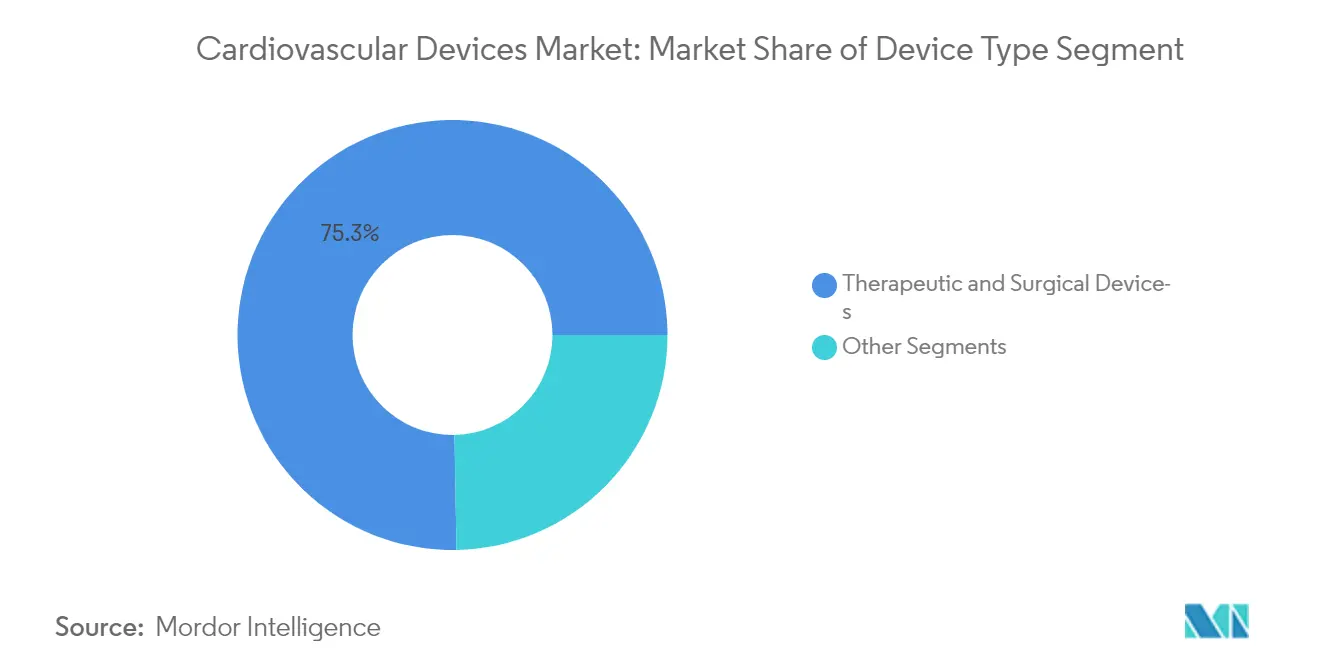
Diagnostic Devices: The Growth Engine
While smaller in current market size, diagnostic and monitoring devices are emerging as the fastest-growing segment in the cardiovascular medical devices space. The higher growth rate of the segment reflects healthcare's increasing focus on preventive cardiology, early detection, and ongoing patient monitoring. Modern solutions like Philips' remote monitoring systems, which track 1.2 million patients yearly and handle 4 billion heartbeat transmissions daily, exemplify this trend. The growth trajectory presents a clear strategic direction for industry players: companies that excel in AI-enabled diagnostics and seamless remote monitoring technologies are positioned to capture significant value as the cardiovascular market shifts toward prevention and continuous care models.
The Interconnected Web of Cardiovascular Technologies
The broader cardiovascular devices ecosystem features multiple subsegments undergoing distinct but interconnected evolutions. ECG technology continues to become more portable and cloud-connected, while imaging solutions expand their impact—with systems like Philips' cardiac ultrasound supporting over 240 million patients yearly. In the therapeutic realm, cardiac rhythm management devices are advancing with longer battery life and remote programming features, while stents and valves incorporate innovative materials and biological engineering approaches. For industry stakeholders, the key insight is that success increasingly depends on integration capabilities—companies that can connect diagnostic insights directly to treatment decisions will create substantially more value than those operating in isolated device categories.
Geography Analysis
North America: Leading the Cardiovascular Devices Market
North America dominates the global cardiovascular devices market with a 51.1% market share in 2025. This leadership comes from advanced healthcare infrastructure, high rates of heart disease, strong reimbursement policies, and the presence of major device manufacturers. The region isn't just the largest market—it sets the pace for innovation in both diagnostic and monitoring devices and therapeutic solutions. In 2024, North America maintained its position as the largest regional market, significantly ahead of Western Europe. For companies in this space, North America remains the essential market where reputations are built and new technologies gain their first major adoption before expanding globally.
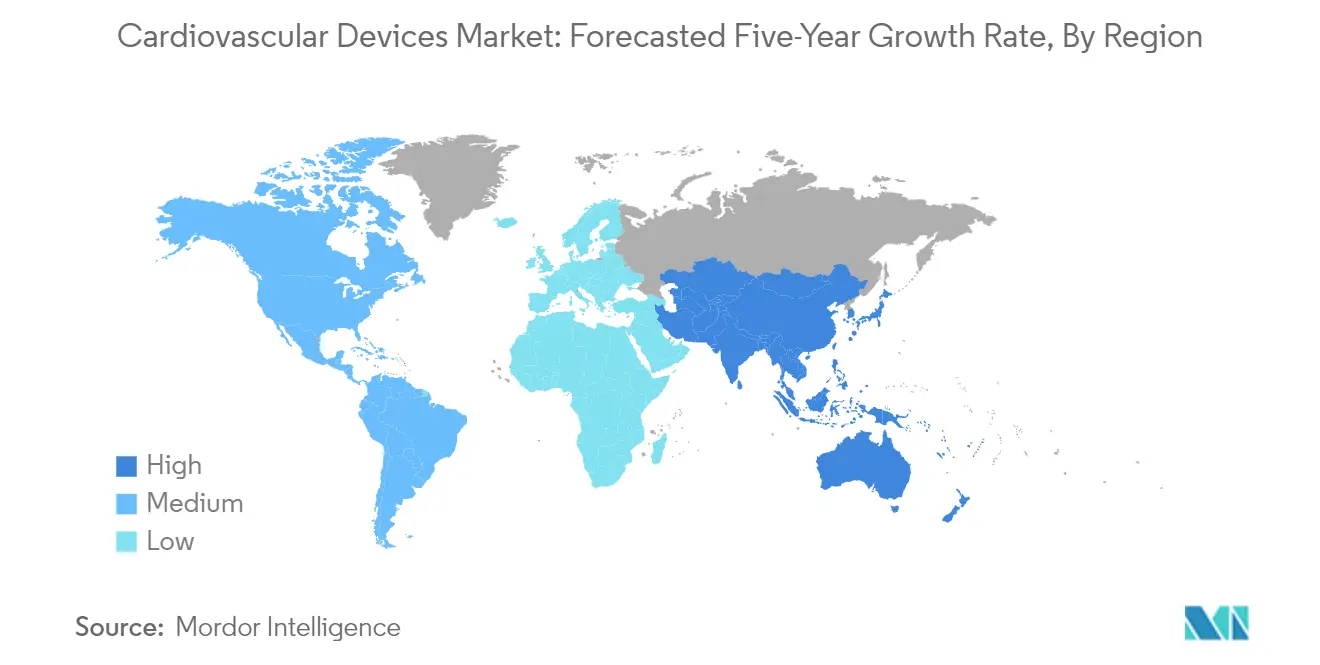
United States: Market Leader with Innovation Focus
The United States leads the North American cardiovascular medical devices market with the largest share of the regional total. This reflects a healthcare system that combines technological innovation with unmatched scale. The United States market stands out for its simultaneous demand for cutting-edge technology and proven cost-effectiveness. A prime example is the ZywieNano patch, which provides 30-day continuous cardiac monitoring that transforms how doctors diagnose heart conditions. This environment creates a unique market where manufacturers must push technology boundaries while navigating complex hospital purchasing systems and insurance relationships. For strategic planning, the key insight isn't just about America's market dominance but understanding how successful product launches provide the credibility and financial foundation needed for global expansion.
Mexico: Growing Force in North American Cardiovascular Care
Mexico is showing the strongest growth within the North American cardiovascular devices landscape. This growth comes from expanding healthcare coverage, growing private hospital networks, and rising rates of lifestyle-related heart conditions. Mexico offers a unique combination of established healthcare infrastructure with emerging market growth potential. For device manufacturers, the opportunity lies in developing products that balance advanced technology with affordability. Companies that can successfully navigate Mexico's regulatory system while adapting their product offerings to local clinical needs are well-positioned to capture significant value in this rapidly developing market.
Canada: Focused on Effective, Value-Based Care
Canada completes the North American cardiovascular devices market with its approach that combines universal healthcare coverage with careful technology adoption. The Canadian system stands out for its centralized evaluation methods that focus on both clinical effectiveness and cost efficiency, creating a more measured approach to new cardiovascular technologies. This systematic approach means Canadian hospitals often use fewer devices overall but maintain quality outcomes through strategic implementation. For cardiovascular device companies, Canada offers not just an additional market but a valuable testing ground where success demonstrates a technology's fundamental value beyond novelty. As healthcare systems worldwide increasingly focus on value-based care, technologies that prove their worth in Canada's efficiency-focused system gain an advantage in similar markets globally.
Europe: Balancing Innovation with Healthcare Sustainability
Europe represents the second-largest region in the global cardiovascular devices market, serving as a critical market where clinical innovation meets healthcare sustainability. The continent influences global standards through its MDR regulatory framework, setting the bar for device safety and effectiveness. Europe's approach to cardiovascular devices is characterized by sophisticated reimbursement systems that increasingly require real-world evidence alongside clinical data. This creates a challenging environment where success depends on demonstrating both clinical and economic value. In Spain, Philips' ePatch extended-wear Holter monitors have gained significant adoption, with fourteen Spanish healthcare facilities now using these devices to detect heart rhythm disorders. For market participants, Europe serves as an essential testing ground where technologies must prove both their clinical benefits and economic value.
Germany: Engineering Excellence in Cardiovascular Technology
Germany leads Europe's cardiovascular devices market with the largest share among European countries. This leadership comes from a strong public-private healthcare system, an emphasis on specialized medical care, and a tradition of engineering excellence that extends to medical technology. The German market demands both clinical evidence and technological sophistication, creating an environment where successful devices must be innovative and thoroughly documented. For device manufacturers, Germany offers more than just market share—success with German specialists often signals readiness for broader European expansion. The key strategy isn't simply capturing the German market percentage but leveraging the country's reputation for medical quality to build credibility across Europe.
United Kingdom: Reshaping Cardiovascular Care Delivery
The United Kingdom shows the highest growth rate in Europe's cardiovascular devices sector despite system-wide challenges. This growth comes from the UK's restructuring of cardiovascular care pathways, with emphasis on earlier diagnosis, community-based management, and innovative care models. Unlike continental European markets, the UK combines centralized technology assessment through NICE with regional implementation decisions, creating multiple entry points for new devices. As healthcare systems globally face resource limitations, technologies that improve system-wide efficiency beyond direct clinical benefits see stronger growth. For cardiovascular medical device companies, the UK provides not just a growth market but insights into succeeding in healthcare systems undergoing major transformation.
Europe's Diverse Markets: Regional Approaches to Cardiovascular Care
Beyond Germany and the UK, Europe's cardiovascular devices market shows diverse approaches reflecting different healthcare priorities and economic conditions. France emphasizes sophisticated technology solutions with centralized decision-making, while Italy combines innovation centers with regional implementation differences. Spain demonstrates rapid adoption even with budget constraints, as shown by University Hospital Vall d'Hebron in Barcelona using ePatch technology to speed up hospital discharges for 80 patients in 2023, reducing hospital stays and emergency room pressure. Nordic countries focus on comprehensive evaluation systems that consider long-term outcomes alongside immediate benefits. This diversity creates both challenges and opportunities for cardiovascular device companies—requiring tailored strategies but offering multiple paths to European success. The key insight is that Europe isn't a single market but a network of connected healthcare systems where success in one country can create momentum across borders when approached with cultural awareness.
Asia-Pacific: The Growth Engine of Cardiovascular Innovation
Asia-Pacific leads global growth in the cardiovascular devices market with the highest growth rate, reshaping competitive dynamics across the industry. This growth comes from rapidly aging populations, expanding middle classes with access to advanced healthcare, and major investments in medical infrastructure. The region is increasingly becoming a source of innovation rather than just a target market. Cardiovascular diseases are now the top reported medical condition in Asia-Pacific for 2024, ranking ahead of cancer and tumors. This shift indicates both an urgent clinical need and a substantial market opportunity. For global companies, success requires more than capturing market share—it means rethinking product development and commercial strategies to address the region's unique clinical needs, price sensitivities, and healthcare delivery approaches. Companies that view Asia-Pacific not just as a growth market but as a source of new ideas will gain a lasting competitive advantage.
Middle East and Africa: Contrasting Opportunities in Cardiovascular Care
The Middle East and Africa region presents contrasting scenarios within the global cardiovascular devices market—combining premium care segments with large underserved populations. This creates a unique market dynamic where advanced technologies and basic access solutions must coexist in company offerings. GCC countries have established centers of excellence with modern cardiac care facilities adopting the latest cardiovascular medical equipment, while across much of Africa, the focus remains on building basic cardiac care infrastructure. This regional contrast challenges the standard approach to cardiovascular technologies. The key insight for market participants is that success in this region requires flexible business models—from premium offerings in urban centers to innovative financing options in developing markets. For forward-thinking companies, the Middle East and Africa offer not just current opportunities but a testing ground for developing approaches to make advanced cardiac care more accessible globally.
South America: Value-Focused Innovation in Cardiovascular Technology
South America has carved out a distinctive position in the global cardiovascular devices market by focusing on value-driven innovation that balances clinical effectiveness with economic sustainability. The region approaches cardiovascular care with two priorities: expanding access while managing limited resources. This creates a market where successful devices must show not just clinical benefits but system-wide value. Brazil leads the regional market, combining significant scale with increasingly sophisticated regulatory frameworks that influence neighboring countries. For manufacturers, the key insight is that technologies demonstrating meaningful outcomes while addressing the region's economic diversity gain larger market share. The cardiovascular medical devices sector in South America shows that innovation isn't just about technological advancement but creating solutions that work within the practical constraints of diverse healthcare systems.
Cardiovascular Devices Industry Overview
Innovation Economics: The R&D Arms Race Reshaping Market Leadership
In today's cardiovascular devices landscape, companies gain a competitive edge by launching breakthrough technologies faster than their rivals. Major cardiovascular device companies are now focusing R&D budgets on disruptive innovations rather than minor improvements, creating a market where early innovators see greater returns. HeartBeam's VECG technology, which creates 3D maps of heart electrical activity, shows how companies are using advanced technology rather than competing on price. Patent strategies are also evolving—HeartBeam's third US patent for its AIMIGo device (part of 11 US patents and 15 total patents) demonstrates how companies are building innovation barriers that competitors can't easily overcome. Companies that strategically identify and develop new technologies in the cardiovascular medical devices sector are gaining market advantage, especially in high-growth segments like Diagnostic and Monitoring Devices—faster than the overall market growth rate.
Portfolio Orchestration: Beyond Simple Scale vs. Specialization
The cardiovascular market is seeing a shift in how companies position themselves—moving past the old choice between being either big or specialized. The most successful players in the cardiovascular devices market are building strategic networks of complementary products that strengthen their main value offerings. This approach is clear in partnerships like the one between UK-based Anumana and Mayo Clinic, which led to FDA clearance for their ECG-AI LEF device that detects potential heart failure. These collaborations let companies access specialized expertise without having to develop everything in-house. Within the Therapeutic and Surgical Devices segment, which makes up 75.3% of the market, companies now focus on creating interconnected product systems rather than standalone devices. They recognize that winning now depends on offering complete solutions rather than just individual product features. This strategy works particularly well in North America, which represents about 51.1% of the global cardiovascular device market, where healthcare providers increasingly prefer vendors that offer comprehensive, compatible solutions.
Regulatory Capital: Turning Compliance into Competitive Advantage
Smart companies in the cardiovascular devices sector are transforming their regulatory capabilities from basic compliance functions into strategic assets that create real competitive advantages. The ability to navigate complex regulations efficiently has become a valuable skill that affects product launch timing, costs, and market position. Companies with strong regulatory expertise gain 6-12 month advantages in bringing products to market, especially noticeable in the interventional cardiology devices market where being first translates directly to market share. Anumana's successful FDA 510(k) clearance for its ECG-AI LEF device with the Mayo Clinic shows how regulatory milestones have become key events that investors and analysts watch closely. This expertise is particularly valuable in the growing Asia-Pacific region, where companies must navigate different regulations across multiple countries. Firms that invest in regulatory knowledge, maintain good relationships with regulatory authorities, and include regulatory planning early in product development are creating advantages that competitors struggle to match without significant time investment.
Cardiovascular Devices Market Leaders
-
Boston Scientific Corporation
-
Abbott
-
Medtronic
-
Edwards Lifesciences Corporation
-
Cardinal Health
- *Disclaimer: Major Players sorted in no particular order
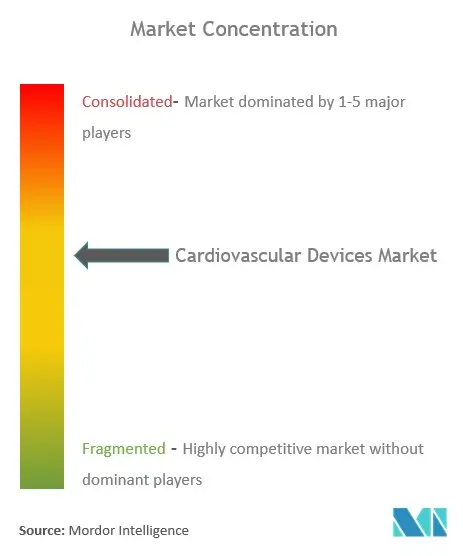
Cardiovascular Devices Market News
- October 2022: Medtronic plc received United States FDA approval for expanded labeling of a cardiac lead that taps into the heart's natural electrical system, giving patients needed therapy while avoiding complications sometimes associated with traditional pacing methods, such as cardiomyopathy.
- October 2022: Biosense Webster, Inc., part of Johnson & Johnson MedTech launched the HELIOSTAR Balloon Ablation Catheter in Europe. The HELIOSTAR Balloon Ablation Catheter is indicated for use in the catheter-based cardiac electrophysiological mapping (stimulating and recording) of the atria and, when used with a compatible multi-channel RF generator, for cardiac ablation.
Cardiovascular Devices Market Report - Table of Contents
1. INTRODUCTION
- 1.1 Study Assumptions and Market Definition
- 1.2 Scope of the Study
2. RESEARCH METHODOLOGY
3. EXECUTIVE SUMMARY
4. MARKET DYNAMICS
- 4.1 Market Overview
-
4.2 Market Drivers
- 4.2.1 Rapid Technological Advancements
- 4.2.2 Increasing Burden of Cardiovascular Diseases
- 4.2.3 Increased Preference for Minimally Invasive Procedures
-
4.3 Market Restraints
- 4.3.1 Stringent Regulatory Policies and Product Recalls
- 4.3.2 High Cost of Instruments and Procedures
-
4.4 Porter's Five Forces Analysis
- 4.4.1 Threat of New Entrants
- 4.4.2 Bargaining Power of Buyers/Consumers
- 4.4.3 Bargaining Power of Suppliers
- 4.4.4 Threat of Substitute Products
- 4.4.5 Intensity of Competitive Rivalry
5. MARKET SEGMENTATION (Market Size by Value - USD million)
-
5.1 Device Type
- 5.1.1 Diagnostic and Monitoring Devices
- 5.1.1.1 Electrocardiogram (ECG)
- 5.1.1.2 Remote Cardiac Monitoring
- 5.1.1.3 Other Diagnostic and Monitoring Devices
- 5.1.2 Therapeutic and Surgical Devices
- 5.1.2.1 Cardiac Assist Devices
- 5.1.2.2 Cardiac Rhythm Management Devices
- 5.1.2.3 Catheters
- 5.1.2.4 Grafts
- 5.1.2.5 Heart Valves
- 5.1.2.6 Stents
- 5.1.2.7 Other Therapeutic and Surgical Devices
-
5.2 Geography
- 5.2.1 North America
- 5.2.1.1 United States
- 5.2.1.2 Canada
- 5.2.1.3 Mexico
- 5.2.2 Europe
- 5.2.2.1 Germany
- 5.2.2.2 United Kingdom
- 5.2.2.3 France
- 5.2.2.4 Italy
- 5.2.2.5 Spain
- 5.2.2.6 Rest of Europe
- 5.2.3 Asia-Pacific
- 5.2.3.1 China
- 5.2.3.2 Japan
- 5.2.3.3 India
- 5.2.3.4 Australia
- 5.2.3.5 South Korea
- 5.2.3.6 Rest of Asia-Pacific
- 5.2.4 Middle East and Africa
- 5.2.4.1 GCC
- 5.2.4.2 South Africa
- 5.2.4.3 Rest of Middle East and Africa
- 5.2.5 South America
- 5.2.5.1 Brazil
- 5.2.5.2 Argentina
- 5.2.5.3 Rest of South America
6. COMPETITIVE LANDSCAPE
-
6.1 Company Profiles
- 6.1.1 Abbott
- 6.1.2 Boston Scientific Corporation
- 6.1.3 Cardinal Health
- 6.1.4 General Electric (GE Healthcare)
- 6.1.5 W. L. Gore & Associates, Inc.
- 6.1.6 Medtronic
- 6.1.7 Biotronik
- 6.1.8 Siemens Healthcare GmbH
- 6.1.9 Canon Medical Systems Corporation
- 6.1.10 Edwards Lifesciences Corporation
- 6.1.11 B. Braun SE
- 6.1.12 LivaNova PLC
- *List Not Exhaustive
7. MARKET OPPORTUNITIES AND FUTURE TRENDS
Cardiovascular Devices Industry Segmentation
As per the scope of the report, cardiovascular devices are used for the diagnosis of heart diseases and treatment of related health problems. The Cardiovascular Devices Market is Segmented by Device Type (Diagnostic and Monitoring Devices [Electrocardiogram (ECG), Remote Cardiac Monitoring, and Other Diagnostic and Monitoring Devices] and Therapeutic and Surgical Devices [Cardiac Assist Devices, Cardiac Rhythm Management Devices, Catheters, Grafts, Heart Valves, Stents, and Other Therapeutic and Surgical Devices]) and Geography (North America, Europe, Asia-Pacific, Middle East and Africa, and South America). The market report also covers the estimated market sizes and trends for 17 different countries across major regions globally. The report offers the value (in USD million) for the above segments.
| Device Type | Diagnostic and Monitoring Devices | Electrocardiogram (ECG) | |
| Remote Cardiac Monitoring | |||
| Other Diagnostic and Monitoring Devices | |||
| Therapeutic and Surgical Devices | Cardiac Assist Devices | ||
| Cardiac Rhythm Management Devices | |||
| Catheters | |||
| Grafts | |||
| Heart Valves | |||
| Stents | |||
| Other Therapeutic and Surgical Devices | |||
| Geography | North America | United States | |
| Canada | |||
| Mexico | |||
| Europe | Germany | ||
| United Kingdom | |||
| France | |||
| Italy | |||
| Spain | |||
| Rest of Europe | |||
| Asia-Pacific | China | ||
| Japan | |||
| India | |||
| Australia | |||
| South Korea | |||
| Rest of Asia-Pacific | |||
| Middle East and Africa | GCC | ||
| South Africa | |||
| Rest of Middle East and Africa | |||
| South America | Brazil | ||
| Argentina | |||
| Rest of South America | |||
Cardiovascular Devices Market Research Faqs
How big is the Cardiovascular Devices Market?
The Cardiovascular Devices Market size is expected to reach USD 61.82 billion in 2025 and grow at a CAGR of 4.97% to reach USD 78.78 billion by 2030.
What is the current Cardiovascular Devices Market size?
In 2025, the Cardiovascular Devices Market size is expected to reach USD 61.82 billion.
Which is the fastest growing region in Cardiovascular Devices Market?
Asia Pacific is estimated to grow at the highest CAGR over the forecast period (2025-2030).
Which region has the biggest share in Cardiovascular Devices Market?
In 2025, the North America accounts for the largest market share in Cardiovascular Devices Market.
What years does this Cardiovascular Devices Market cover, and what was the market size in 2024?
In 2024, the Cardiovascular Devices Market size was estimated at USD 58.75 billion. The report covers the Cardiovascular Devices Market historical market size for years: 2021, 2022, 2023 and 2024. The report also forecasts the Cardiovascular Devices Market size for years: 2025, 2026, 2027, 2028, 2029 and 2030.
Our Best Selling Reports
Cardiovascular Devices Industry Report
The global cardiovascular devices market is experiencing significant market growth, driven by the increasing prevalence of chronic heart diseases and the rising demand for advanced diagnostic and surgical cardiology devices. Supported by a wave of drug approvals, clinical trials, and significant reductions in the prices of key therapeutic devices, these developments are enhancing accessibility in emerging markets. Robust R&D efforts are fostering innovations in product development, aiming to boost patient outcomes with advanced features like remote cardiac monitoring for enhanced safety and efficiency.
Despite challenges such as complex regulatory frameworks, the market's potential for growth remains strong, driven by technological advancements and improved healthcare accessibility, indicating a promising outlook for the cardiovascular devices sector. The market analysis reveals that the industry trends are shaping a positive industry outlook, with market segmentation playing a crucial role in understanding the market value and market size.
The industry research highlights the importance of market leaders in driving the market data and market forecast, ensuring a comprehensive market overview and market predictions. Industry reports provide valuable industry information and industry statistics, contributing to a detailed industry analysis and industry review. The report example and report PDF offer insights into market growth and market segmentation, emphasizing the importance of industry sales and industry size in the overall market outlook.
In conclusion, the cardiovascular devices market is set for a robust growth rate, supported by detailed industry research and market data. The market forecast and market predictions indicate a strong market value, with industry trends and market overview pointing towards a positive industry outlook. The industry reports and research companies provide a comprehensive analysis, ensuring that the market remains well-informed and prepared for future developments.




